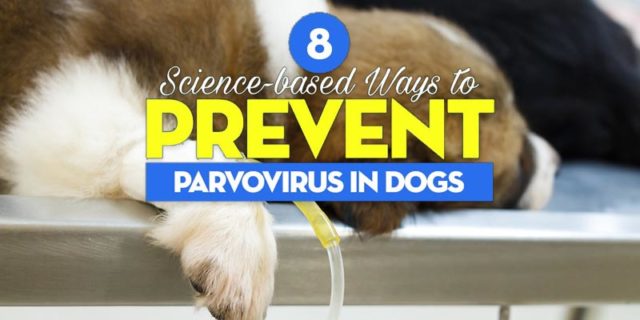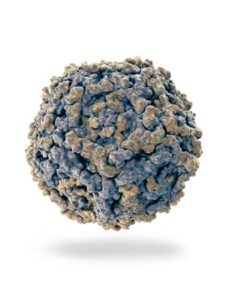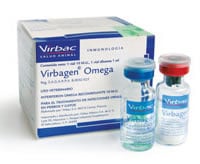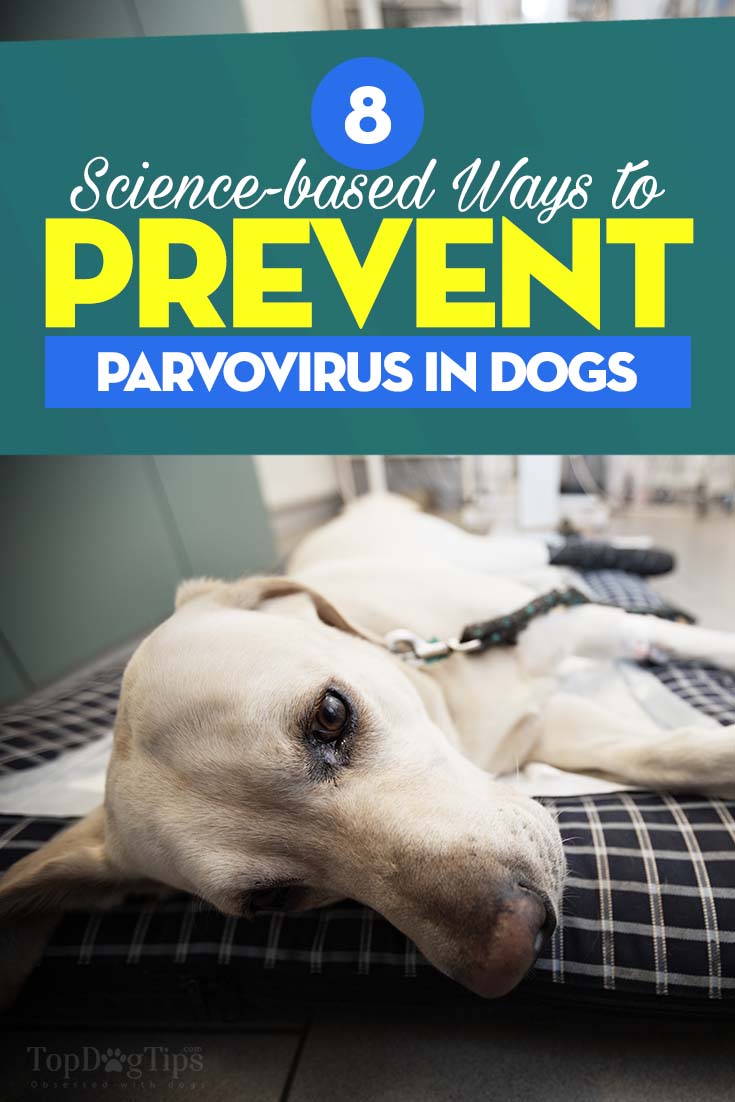
Table of Contents
A very common and highly contagious viral parvovirus in dogs can be fatal.
Parvo attacks the cells that are rapidly dividing, such as white blood cells and cells in the intestinal tract.
Puppies younger than 4-month-old dogs that have not been vaccinated are most at risk.
But there are several other science-based ways to prevent Parvovirus in dogs, and we'll go over them now.
I've gone through hundreds of studies on canine parvovirus to see what science has found to be the most effective way to deal with canine parvovirus up to this date.
Not surprisingly, vaccines remain the most effective method, but I've also managed to find seven other options to significantly decrease the chances of your dog contracting the virus.
I'll show you some data that I've found alongside these options, too.
Here are the general symptoms of dog parvovirus just to keep in mind:
- Lethargy
- Severe vomiting
- Loss of appetite
- Diarrhea
- Severe dehydration
Parvovirus in dogs can lead to death, with studies showing a mortality rate of up to 10% in adult dogs and 91% in puppies (Nandi et al., 2010).
In general, it's been observed that without appropriate treatment or prevention, the overall parvovirus mortality rate in dogs will be as high as 91%.
In this article, I'm going to review eight evidence-based treatments to prevent parvovirus in dogs.
As with any other health condition in canines, prevention is a much better option than treatment after the fact.
Parvovirus in dogs is a very serious condition, and it's important that you educate yourself about it and the preventative measures that you can take to keep your canine companion safe.
ALSO READ: 7 Resources to Help You Understand Parvovirus
8 Ways to Treat and Prevent Parvovirus in Dogs
1 Vaccination
A vaccine is a substance that triggers the production of antibodies in the dog's body, which can provide immunity against disease.
Vaccinations work because they contain a small amount or parts of the bacteria or virus that result in disease.
But, like with all vaccines, there is always some risk involved, which is why it's important that you understand first how they function.
 Here's a quick evidence-based guide from the CDC that explains the process of vaccination.
Here's a quick evidence-based guide from the CDC that explains the process of vaccination.
Basically, once the dog's body detects this foreign material, the immune system will start producing antibodies to destroy the disease cells.
The antibodies stay in the body for a long time, allowing the immune system to fight off the real germs before they have the opportunity to cause sickness.
But how effective parvovirus vaccines actually are?
Research has shown that vaccines are currently the most effective way to fight parvo and prevent parvovirus in dogs.
An epidemiological study of 9 years demonstrated that dogs were 12.7 times more likely to be admitted with canine parvovirus if not vaccinated (Houston et al. 1996).
One vaccine based on a recombinant plant virus that displays a particular protein of the canine parvovirus was effective for protection and virus shedding (Lengeveld et al. 2001).
In addition, this vaccine resulted in an increase in the production of parvovirus antibodies in dogs.
The Bottom Line: Vaccinating your puppy is currently the most effective (and the easiest) way to prevent parvovirus in dogs.
2 Physical Separation
Parvovirus is an extremely contagious virus that can pass easily from one dog to another.
In fact, parvovirus is so common that it was shown to be easily transmitted between a diverse range of carnivores, including pumas, coyotes, wolves, and bobcats (Allison et al. 2013).
As such, parvo is much more prevalent in wildlife, and professionals need an effective way to prevent the spread of it.
It's best to review their methods and use what they use to prevent parvovirus in dogs and avoid the spread.
Here's the IUCN's official approach (PDF) to dealing with parvo.
So, how exactly do they approach this?
To nobody's surprise, the most common (and basic) method IUCN's conservationists and wildlife managers use to reduce the transmission of disease between animals is to separate the animals physically.
Thus, it stands to reason that physically separating dogs will help to prevent the transmission of the virus.
The Bottom Line: Physically separating dogs may be the easiest way to prevent parvo spread.
3 Keeping a Clean Area
Parvovirus can be transmitted to other dogs when that animal comes in contact with an infected dog’s feces.
Thus, it should come as no surprise that maintaining a clean area can help to prevent the transmission of canine parvovirus.
According to some studies, infectious disease transmission can occur in 6-60% of human households in which one member is sick (Kagan et al. 2002).
In the case of canine parvovirus, infected dogs can shed large quantities of the virus in their stool for approximately 2 weeks after exposure.
The use of antimicrobial disinfectants can be (the most) effective way to decontaminate an area in your home, as routine cleaning may not be sufficient.
In fact, some research demonstrated that parvovirus can resist harsh environments and some disinfection products (Eterpi et al. 2009)
Then, can a disinfectant really be effective against parvo in your home?
It turns out that, yes, it still can be. In the following study from the same authors (Eterpi et al. 2010), the use of two alkaline cleaners, specifically CIP-100 and ProKlenz-One, and two liquid disinfectants, namely SporKlenz and a peracetic-based formulation, resulted in the inactivation of viral activity.
Another study (Eleraky et al. 2002) showed that the use of chlorine dioxide and potassium peroxymonosulfate as disinfectant agents was effective in deactivating feline herpesvirus, feline calicivirus, and feline parvovirus.
 To sum up, here are the proven cleaners you may want to use against parvo before and/or after your dog contracts the virus:
To sum up, here are the proven cleaners you may want to use against parvo before and/or after your dog contracts the virus:
- CIP-100
- ProKlenz-One
- SporKlenz
- Peracetic-based formulations
- Products with chlorine dioxide
- Products with potassium peroxymonosulfate
Other strategies to keep your dog’s area clean are to clean or, better yet, throw out any dog toys, water bowls, and food dishes after your dog becomes infected with parvovirus.
It's better to be safe than sorry, and getting rid of these items is the safest way to prevent parvovirus in dogs from spreading at home.
The Bottom Line: Use proven disinfectants to clean your home, and throw out some of the things your dog has put in his mouth and may come in contact with again.
4 Antibiotics
Antibiotics are antimicrobial drugs that are used to prevent bacterial infections. They work the same way in dogs as they do for our health.
While you should not use antibiotics to prevent parvovirus in dogs just in case, they have been proven to work well as a treatment for canine parvovirus.
For example, a broad spectrum of antibiotics (ampicillin, chloramphenicol, erythromycin, gentamycin), along with the restoration of fluids and electrolytes, were shown in studies to be effective against parvo in dogs (Nandi et al. 2010).
In general, antibiotics work by affecting parts of the bacterial cell that have no effect on the host’s cell. For example, because dogs do not have cell walls, an antibiotic may selectively destroy the cell walls of bacteria (Debono et al. 1994).
Although parvovirus is a virus and not a bacteria, antibiotics help to protect your dog’s body against bacterial infection during a time when they may be immune-compromised due to the viral infection.
The Bottom Line: Antibiotics are proven to be an effective treatment for canine parvovirus.
5 Echinacea
Echinacea is an herb that is known to improve resistance to infections. Numerous studies on Echinacea show that this extract can shorten the duration and severity of infection if given immediately after the symptoms arise (Block et al. 2003).
Echinacea has been tested with dogs in numerous studies, but we have yet to see any conclusive evidence of how effective it can be specifically for preventing or treating parvovirus in dogs.
Nevertheless, in one study, it was shown to be an effective treatment for infections in dogs (Reichling et al. 2003).
A different study observed its potential for positively stimulating the dog's immune system (Torkan et al. 2015).
In another study, healthy rats that were administered Echinacea purpurea root powder had increased expression of mRNA of cytokines, specifically interleukins and tumor necrosis factors (Uluisik et al. 2012).
Cytokines are cells that act as signals in the body to aid communication for the immune response so that immune cells can move toward sites of infection or trauma.
A similar study showed that Echinacea at a dose of 0.75g/kg increased the levels of the tumor necrosis factor, a specific type of cytokine.
Conclusively, with increased cytokine concentrations, Echinacea has the potential to trigger the immune system to fight off parvovirus in dogs.
The Bottom Line: Echinacea may be an effective way to prevent parvovirus in dogs, but more evidence is still needed.
6 Granulocyte Colony-Stimulating Factor
Granulocyte colony-stimulating factor (GCSF) is a glycoprotein that stimulates the production of granulocytes and stems in the bone marrow, which are then released into the bloodstream.
A particularly important type of white cell, granulocytes contain small granules within the cell, which contain proteins and enzymes that can destroy bacterial cell walls.
In other words, granulocytes are the dog's immune system’s first line of defense against foreign invaders, like canine parvovirus.
While some old studies did not find any positive effects of GCSF for puppies with parvovirus, a newer study has concluded that there's something promising in this approach (Duffy et al. 2015).
That said, the researchers observed that survival rates were lower in dogs who were treated with granulocyte colony-stimulating factor, even though there was progress in fighting the virus; therefore, further research is still needed in this area.
The Bottom Line: Granulocyte colony-stimulating factor may be a promising treatment for parvovirus in dogs in the future, but more research is needed.
7 Interferon Omega
Interferon omega is a licensed veterinary product that, since 2002, has been approved in the UK for the treatment of canine parvovirus infection (Shi-Fang Li et al. 2017).
Interferons are a family of naturally occurring proteins that are produced once the body is introduced to viral infections, which subsequently stimulate the immune system cells to attack and destroy the virus cells.
Interferon omega is made through recombinant technology, where an omega gene that is responsible for producing interferon is added into the DNA.

The efficacy of interferon omega was studied in 94 dogs with parvoviral enteritis between the ages of one and 28 months old (de Mari et al. 2003).
Those treated with interferon omega improved significantly compared to the placebo group.
Furthermore, interferon omega resulted in a 4.4-time reduction in the number of deaths caused by parvovirus. In unvaccinated dogs, interferon omega treatment leads to a 6.4-fold reduction in mortality.
In another double-blind, placebo-controlled challenge trial, dogs were inoculated with parvovirus and then divided into a placebo group and an interferon omega treatment group (Martin et al. 2002).
All 5 dogs in the placebo group died within 10 days of parvovirus inoculation.
Only 1 dog treated with interferon omega died, showing that interferon omega can reduce the mortality rate in dogs with parvovirus.
Interferon omega can also improve clinical signs and reduce viral transmission in infected cats (Gil et al. 2013).
Despite the beneficial effects of interferon omega, there may be some side effects, including:
- Hyperthermia immediately after injection for up to 6 hours
- Transitory vomiting
- Fatigue
- Mild diarrhea
European Medicine Agency has released a report regarding Virbagen Omega treatment (PDF).
The Bottom Line: Interferon Omega is a very promising and proven to be an effective treatment for parvovirus in dogs; however, there may be some side effects with its use.
8 Anti-endotoxin Immunotherapy
An anti-endotoxin is a substance that is used to counteract or inhibit the effect of a bacterial endotoxin. Death due to canine parvovirus disease is partly due to an endotoxin, hence the treatment.
In an older study, when an anti-endotoxin was administered to dogs with canine parvovirus, there was a 16.8% decrease in patient mortality compared to the control group (Wessels et al. 1986).
In addition, anti-endotoxin treatment resulted in less time in the hospital for surviving dogs.
That said, antiendotoxin immunotherapy remains one of the least studied treatments or ways to prevent parvo in dogs, and in order to consider it more seriously, we need more research in this area.
The Bottom Line: While some studies show that antiendotoxin immunotherapy might be an effective way to treat parvovirus in dogs, there's still not enough research in this area to recommend it.
Preventing Parvovirus in Dogs: Before You Go…
There is no easy way to look at it. Parvovirus is here; it’s real, it’s a killer, and it’s highly contagious among dogs.
After going through hundreds of studies on canine parvovirus treatments and prevention methods, I have to say that only a few seem to be solid recommendations, while most others are either lacking in evidence or are still in their infancy.
We know today that vaccinating your dog is the most effective way to prevent parvovirus in dogs.
After that, keeping your dog's area clean may be a good preventative way to avoid further infections in a post-parvo world.
For canine parvovirus treatment, physical separation and antibiotics, alongside fluid therapy, are currently the most effective methods.
As serious as this topic is, dog owners should find a bit of comfort in knowing several effective treatments and ways to prevent parvovirus in dogs, ranging from the use of logic and exercising proper hygiene to the use of highly specific immunotherapy.
The solution is out there; now, it is just a matter of deciding the best way to prevent parvovirus in dogs.
READ NEXT: 3 Dog Food Diets To Prevent Diseases (Based On Science)













